Adenium - Desert Rose Plant
Desert rose plant is a gorgeous succulent that's easy to grow indoors. Discover how to care for desert rose as a houseplant, when to repot, water, and fertilize, plus how to make this beauty bloom
Adenium (Adenium) is a slow-growing indoor plant belonging to the Apocynaceae family.
Recently, it has gained popularity due to its exotic appearance. Picture a small tree or bush with a thick stem, featuring a swelling at the base (caudex), adorned with large flowers in white, red, or burgundy. Its leaves are a vibrant green, shiny, or velvety.
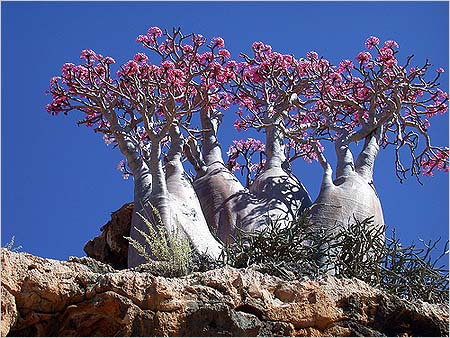
In nature, adenium can be found in Saudi Arabia, Yemen, Oman, and various countries in Africa. Additionally, it is cultivated as a decorative plant in tropical countries such as India, Thailand, and Malaysia. Adenium goes by popular names such as the desert rose, Sabi star, and impala lily.
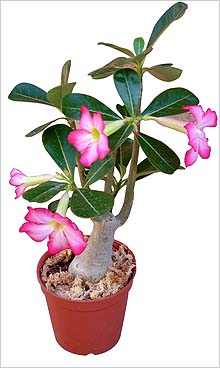
In indoor conditions, the plant typically grows to no more than half a meter, while in its natural habitat, it can reach up to 3 meters. The leaves grow on thin branches at the top of the main stem, displaying various shapes depending on the species. They are usually green, elongated, and slightly pointed, turning yellow and falling off during periods of dormancy. Adenium flowers come in different shades - red, white, yellow, pink - and can be up to 6 cm in size, arranged in clusters. The flowers remain vibrant for over a week.
Due to its slow growth, adenium is suitable for succulent and cactus compositions. The adenium obesum, a fairly undemanding variety, is most commonly encountered in indoor cultivation. Its leaves are typically green, elongated, round, or slightly pointed at the tips, with some varieties exhibiting variegation. Variegated types are more demanding, requiring excellent lighting, and may bloom less due to a lack of sunlight.
In recent times, numerous new adenium varieties with diverse flower colors have become popular, ranging from pure white to deep dark red, and even burgundy with hints of blue. Some flowers feature variegated patterns, with spots, streaks, and stripes on the petals.
Adenium begins flowering at around 2 years of age. It's essential to note that the sap of all parts of the adenium plant is toxic. Working with gloves is recommended, and rubbing your eyes with hands should be avoided, as the sap, when absorbed through the skin, can cause poisoning. Many adenium enthusiasts claim not to use gloves but emphasize thorough handwashing after handling the plant, reporting no signs of poisoning.
This plant is not recommended for households with small children!
Desert Rose Plant Care
Light. Adenium requires good lighting, ideally receiving several hours of direct sunlight each day. Insufficient light can lead to elongation, poor flowering, or a complete lack of blooming. Southern windows are ideal for providing the necessary light.
Humidity. Adenium is not particularly sensitive to humidity and can thrive in various humidity levels.
Water. Desert Rose Plant is a relatively low-maintenance indoor plant. The watering rules are straightforward: during hot weather, water generously with warm water, and in colder periods, water sparingly, similar to cacti. During the growing and flowering season in spring and summer, watering can be more frequent, but in cool weather, reduce watering to prevent root rot. An alternative approach is to water infrequently but thoroughly, allowing the soil to dry out before watering again. It's a good idea to use a pot with drainage holes to prevent soggy potting medium.
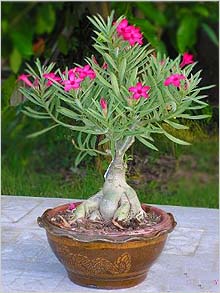
Crown and Stem Formation: Some adenium varieties naturally branch out at a young age, but for crown formation, it's recommended to pinch the top at the end of winter, just before the onset of vigorous growth. Adult plants can have unnecessary branches pruned or removed.
Caudex Formation: The caudex naturally develops with age. To achieve a complex caudex shape, a simple technique involves lifting the plant during transplanting so that some roots are exposed above the soil level. The roots thicken, forming an intricate stem. Young plants can also be tilted and fixed to encourage a unique stem shape. Pruning stimulates the growth of new leaves and flowering in mature plants.
Repotting. Adenium has a robust root system that quickly expands, requiring ample space. Young plants should be transplanted annually in early spring. Choose a sufficiently large, preferably light-colored pot to prevent overheating on sunny windowsills. Good drainage is essential.
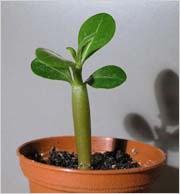
Soil. Adenium thrives in nutrient-rich, loose, and well-draining soil with a slightly acidic to neutral pH. Recommended soil components include leafy soil, perlite, coarse sand, along with additions of charcoal, crushed brick, or bits of styrofoam. A small amount of peat can also be beneficial. Commercial succulent soil can be used.
Fertilizer. Adenium responds positively to fertilizers. Feed once or twice a month during the growth period.
Dormant Period. Some adenium species shed leaves partially or entirely during dormancy. In winter, maintain a temperature of 10-15°C, with watering significantly reduced and eventually halted. Decrease lighting during this period. In spring, move the plant to a bright window, gradually increasing watering as buds awaken. If providing winter coolness is challenging, continue minimal watering but reduce it to a minimum.
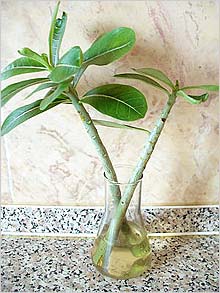
Propagation:
- Seeds: If purchasing adenium is not feasible, seeds can be ordered online. Sow in spring, as adenium seeds lose viability quickly. Before sowing, soak seeds for 2 hours and plant in a mix of sand, perlite, and crushed charcoal. Germinate at temperatures not below 24°C. Seedlings emerge in 1-2 weeks. Protect them from direct sunlight.
- Cuttings: Propagation through cuttings is straightforward. Cut a stem of at least 10 cm, let the cut end dry for 1-2 days, treat with a root growth stimulator, and root in a mix of sand, perlite, and crushed charcoal. Cover the cutting to retain moisture. Rooting temperature should be 24-26°C.
- Air Layering: This method involves taking cuttings with a diameter of at least 2 cm during the active growing season. Make a circular incision, dry the cut, treat it with a rooting stimulant, wrap it with moist sphagnum moss, and cover with opaque polyethylene. Keep the moss moist. Once roots form in about a month, detach and plant the cutting.
Diseases and Pests. Adenium is susceptible to root rot, mealybugs, mites, and spider mites. Standard remedies for these pests are effective.




